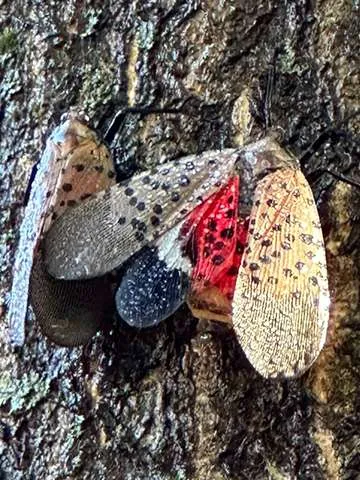Using Tree Pruning and Removal to Combat Spotted Lanternflies

The spotted lanternfly is an invasive insect that has quickly spread across New York City, inflicting considerable harm to trees and plants. This pest presents a major risk to local ecosystems, especially since it targets numerous tree species. As a homeowner or property manager, it’s important to take proactive measures to safeguard your trees from this destructive insect. Two of the most effective ways to manage spotted lanternflies are through tree pruning and, in more severe cases, tree removal. Understanding Spotted Lanternflies The spotted lanternfly (Lycorma delicatula) is native to Southeast Asia but has become a major pest in the United States, particularly in the Northeast. It feeds on tree and plant sap, which weakens the host and makes it more susceptible to disease. The insect’s feeding habits leave behind a sticky substance called honeydew, which promotes the growth of sooty mold. This black, sooty mold not only damages the tree but can also cover outdoor surfaces, making it a nuisance for homeowners. The spotted lanternfly has a one-year life cycle, with adults laying eggs in the fall. Egg masses are found on tree trunks, branches, and even man-made structures. The eggs hatch in the spring, and the nymphs begin feeding on a variety of plants before becoming adults in late summer. Pruning as a Preventative Measure Pruning plays a vital role in managing spotted lanternflies, particularly in the early stages of infestation. By removing infested branches, you can reduce the population of lanternflies on your property and slow the spread of the insect to other trees. Focus on pruning branches that show signs of infestation, such as oozing sap, sooty mold, or egg masses. Additionally, pruning helps improve air circulation within the tree’s canopy, which can make the environment less hospitable for the pests. Regular pruning also allows you to monitor the health of your trees more closely. By inspecting your trees during pruning, you can catch early signs of spotted lanternfly activity and take action before the infestation becomes severe. When Removal is Necessary In some cases, pruning alone may not be enough to control a spotted lanternfly infestation, especially if the tree is heavily infested or already weakened by the pest. Tree removal may be necessary to prevent the lanternflies from spreading to other healthy trees on your property or in the surrounding area. Tree removal is a last resort but is sometimes the only effective way to protect the rest of your landscape. When deciding whether to remove a tree, consider the extent of the infestation, the health of the tree, and its value to your property. A certified arborist from NYC Tree Pro can assess the situation and recommend the best course of action. Signs of Spotted Lanternfly Infestation Sooty mold on trees: This black mold is a sign of honeydew excreted by the lanternflies. Oozing sap: Look for sap oozing from small wounds in the tree bark, a common indicator of infestation. Egg masses on tree trunks: These are usually grayish and can be found on the bark, making them easy to spot during pruning. Presence of adult lanternflies: Adults are about an inch long, with long gray wings and black spots with bright red inside, and they often congregate in large numbers. Wilting or yellowing leaves: This can indicate that the tree is under stress from the feeding activity of the lanternflies. Comparison of Pruning vs. Removal for Spotted Lanternfly Control Method Best Used When Benefits Costs Drawbacks Pruning Early stages of infestation Preserves tree health Lower cost, typically $100-$500 May not be sufficient for severe cases Removal Severe infestation, tree decline Prevents further spread Higher cost, typically $500-$2000 Loss of tree, environmental impact Combined Approach Moderate infestation Balances health and control Moderate cost, depending on extent Requires ongoing monitoring Chemical Treatment When combined with pruning Targets lanternflies directly Varies, $100-$300 per application Environmental concerns, effectiveness varies Monitoring & Maintenance After initial treatment Prevents re-infestation Ongoing cost, typically $100-$300 annually Requires regular inspections
The Spotted Lanternfly and the Ailanthus Tree: A NYC Property Owner’s Guide

A Silent Threat: Invasive Species in NYC Invasive Species Origin Ecological Impact Management Strategies Spotted Lanternfly (Lycorma delicatula) China, India, Vietnam Threatens various trees and plants, weakens them with feeding, promotes disease spread. * Tree removal (esp. Ailanthus altissima) * Egg mass scraping * Insecticide application (targeted) * Public awareness and monitoring programs Tree of Heaven (Ailanthus altissima) China Disrupts native plant communities, reduces biodiversity, allelopathic chemicals inhibit surrounding plant growth. * Mechanical removal (cutting/grinding) * Herbicide application (for stumps) * Controlled burns (in some areas) * Planting native species to compete Norway Maple (Acer platanoides) Europe, Western Asia Outcompetes native trees, reduces forest regeneration, dense shade reduces understory growth. * Selective removal to encourage native species * Biological controls (insects/fungus) * Herbicide application (targeted) Kudzu Vine (Pueraria montana var. lobata) Japan, China, Southeast Asia Rapidly smothers native vegetation, alters forest structure, reduces wildlife habitat. * Mechanical removal (pulling/cutting) * Herbicide application (targeted) * Prescribed grazing (in some areas) Common Reed (Phragmites australis) Eurasia, Africa Forms dense monocultures, crowds out native wetland plants, reduces biodiversity. * Controlled burns (winter) * Water level manipulation * Herbicide application (targeted) * Biological controls (insects) The Spotted Lanternfly in NYC: Threat to Trees and Plants New York City faces a double threat from invasive species – the Spotted Lanternfly and the Ailanthus tree (Tree of Heaven). The Spotted Lanternfly, a brightly colored planthopper native to Asia, first arrived in the US in 2014 and has since established itself in several states, including New York. This fast-reproducing pest poses a significant threat to a variety of trees and plants, with a particular fondness for the Ailanthus. They weakens plants, making them susceptible to disease. The Ailanthus Tree: A Not-So-Heavenly Invader The Ailanthus tree, while initially valued for its rapid growth and tolerance of harsh conditions, has become a major problem in NYC due to its aggressive nature. It outcompetes native species for resources, releases chemicals that inhibit nearby plant growth, and can quickly dominate entire landscapes. This disrupts natural ecosystems and reduces biodiversity, creating an environment where invasive species like the Spotted Lanternfly can thrive. NYC’s Spotted Lanternfly History: A Cause for Concern The first sighting of the Spotted Lanternfly in NYC occurred on Staten Island in 2020. Since then, the infestation has spread rapidly across all five boroughs, with particularly high concentrations in Manhattan and the Bronx. Despite ongoing control efforts by state and local agencies, the lanternfly’s rapid reproduction and spread make eradication a significant challenge. The Unfortunate Alliance: Why Ailanthus Trees and Spotted Lanternflies are a Perfect Match The Ailanthus tree acts as a critical host for the Spotted Lanternfly. Here’s why this combination is detrimental to NYC’s urban ecosystem: A Buffet for Lanternflies: Ailanthus trees provide a readily available food source for lanternflies, allowing their populations to explode. A Breeding Ground for Trouble: The abundance of Ailanthus trees facilitates the spread of lanternflies to other parts of the city, threatening a wider range of flora. A Weakened Ecosystem: Both the lanternfly’s feeding and the Ailanthus tree’s allelopathic effects weaken native plants, making them more susceptible to additional threats. Case Studies: NYC Tree Pro Protects Properties from Invasive Species At NYC Tree Pro, our expert arborists have witnessed firsthand the devastating impact of the Spotted Lanternfly and Ailanthus tree on NYC properties. Here are two examples of how we helped property owners combat this invasive duo: Yorkville, Manhattan: A property owner faced a severe Spotted Lanternfly infestation on their Ailanthus trees. The rapid spread threatened nearby plants. NYC Tree Pro recommended removing the Ailanthus trees, eliminating the primary food source for the lanternflies. After removal, lanternfly activity significantly decreased. Follow-up treatments ensured the infestation didn’t return. Spanish Harlem, Manhattan: A community garden’s diverse plant life was at risk due to Spotted Lanternflies on their Ailanthus trees. NYC Tree Pro’s strategic removal plan not only stopped the lanternfly infestation but also allowed native plants to flourish, improving the garden’s overall health and biodiversity. The Benefits of Removing Ailanthus Trees with a Spotted Lanternfly Infestation Removing Ailanthus trees infested with Spotted Lanternflies offers several advantages for NYC property owners: Stops Lanternfly Infestations at the Source: Eliminating the primary food source disrupts the lanternfly life cycle and helps control their population. Protects Native Plants: Removing Ailanthus trees creates space for native species to thrive, promoting a healthier and more diverse ecosystem. Enhances Property Value: A well-maintained property with healthy trees is more aesthetically pleasing and valuable. Addressing invasive species issues improves the overall landscape health. Beyond Ailanthus: Why Managing Invasive Species Matters The Spotted Lanternfly and the Ailanthus tree disrupt the delicate balance of NYC’s ecosystems. They outcompete our native plants and animals for resources, alter habitats, and decrease biodiversity. This can have cascading effects, impacting everything from the health of our urban forests to the overall ecological balance of the city. Taking Action: NYC Tree Pro, Your Partner in Invasive Species Management Expert Arborist Services: At NYC Tree Pro, we understand the complexities of invasive species management. Our team comprises certified arborists with extensive knowledge of both the Spotted Lanternfly and the Ailanthus tree. We possess the expertise to assess your property, determine the best course of action, and safely and effectively remove Ailanthus trees while minimizing disruption to your landscape. Our Ailanthus Tree Removal Process: Comprehensive Tree Inspection: Our arborists will conduct a thorough inspection of your Ailanthus trees and the surrounding area to assess the severity of the Spotted Lanternfly infestation. Customized Removal Plan: Based on the inspection, we’ll develop a personalized removal plan that prioritizes safety and efficiency. This might involve techniques like bucket trucks, cranes, or targeted herbicide application (for stump removal). However it depends on the size, location, and surrounding environment of the trees, as each job is different. Safe and Efficient Removal: Our highly trained crew utilizes state-of-the-art equipment and adheres to strict safety protocols to ensure the safe and efficient removal of Ailanthus trees. Debris Removal and Cleanup: We’ll meticulously remove all debris from the removal




